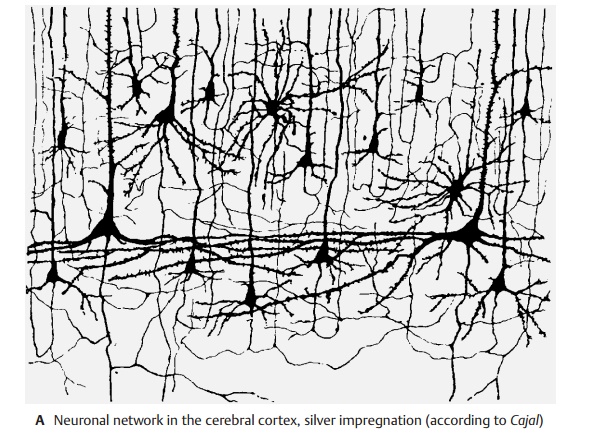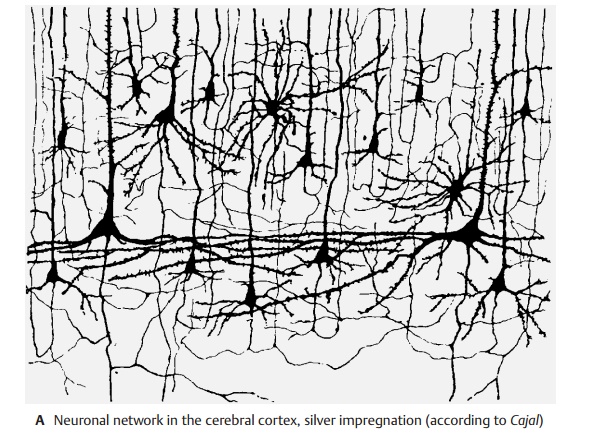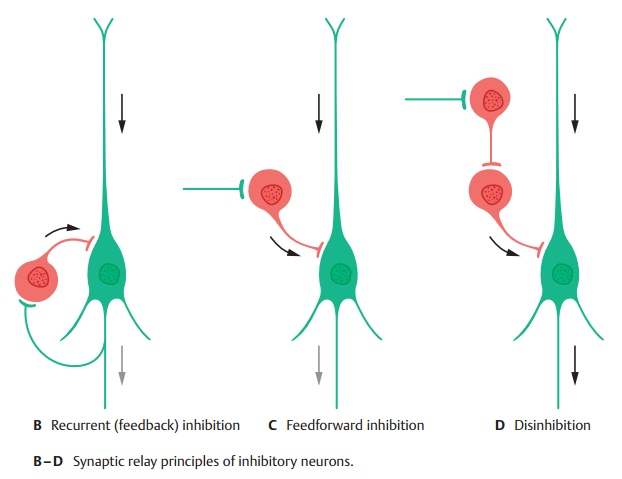Chapter: Human Nervous System and Sensory Organs : Basic Elements of the Nervous System
Neuronal Circuits - Neuronal Systems

Neuronal Circuits
The
nerve cells and their processes form a network (A) that is not a continuum of nerve fibers (continuity theory) but consists of countless individual elements,
the neurons (neuron theory). As the
basic building block of the nervous system, the neuron repre-sents a
structural, genetic, trophic, and functional unit.
The
neurons in the network are intercon-nected in a specific way (neuronal circuits). The connections for
the inhibition of excita-tion are as important as those for the trans-mission
of excitation, for they are the ones through which the continuous influx of
im-pulses is restricted and selected: important signals are transmitted,
unimportant ones are suppressed.
Postsynaptic inhibition does not inhibitsynaptic
transmission but subsequent dis-charge of the postsynaptic neuron.

Inhibitory
GABAergic neurons can be inte-grated into the neuronal circuit in different
ways. In the case of recurrent
(feedback) inhi-bition (B), an
axon collateral of the exci-tatory projection neuron (green) activates the
inhibitory cell (red), which in turn in-hibits the projection neuron via a
recurrent collateral. In the case of feed-forward
inhibi-tion (C), the inhibitory
interneuron is not ac-tivated by a recurrent collateral of the exci-tatory cell
but by excitatory afferents from another brain region. The effect on the
pro-jection neuron, however, is the same; acti-vation of the inhibitory
GABAergic neurons leads to inhibition of the projection neu-rons. In case of disinhibition (D), an inhibi-tory interneuron is again activated by an ex-citatory
afferent. The target cell of this inter-neuron, however, is another inhibitory
in-terneuron. Activation of the first inter-neuron through the excitatory
afferent therefore means an increased inhibition of the second interneuron,
which now cannot exert an inhibitory effect on the next projec-tion neuron. The
inhibitory effect is re-moved (disinhibition).

A single
nerve cell in the brain receives a large number of connections (convergence).One pyramidal cell of the
cerebral cortex can establish over 10 000 synaptic connec-tions with other
nerve cells. In turn, such a cell itself creates numerous connections with many
other nerve cells by numerous axon collaterals (divergence). The spatial
and temporal summation of excitatory
and in-hibitory inputs of a cell decides at a given moment whether the cell is
depolarized and generates an action potential, which then runs along the axon
and leads to excitation of subsequent neurons in the series. If the inhibitory
inputs predominate, the dis-charge of neurons does not take place.
Related Topics